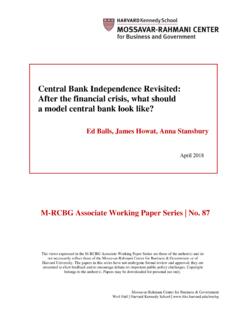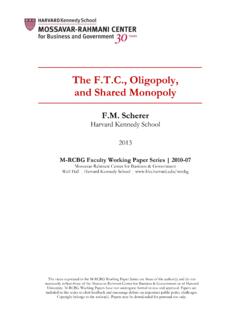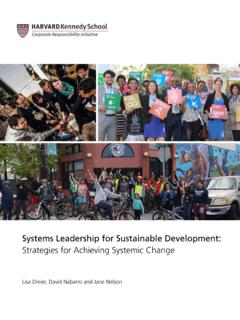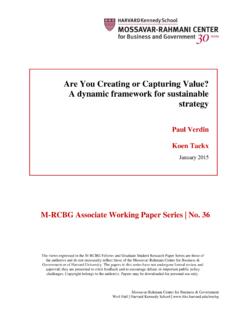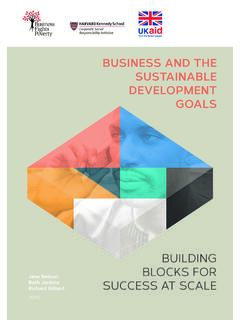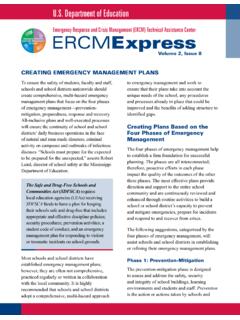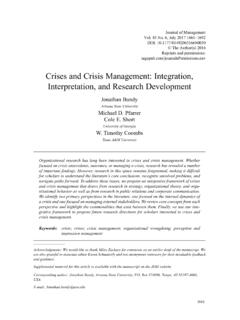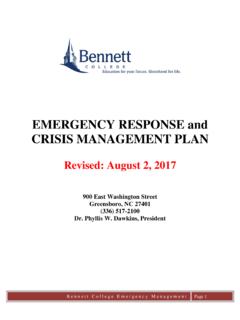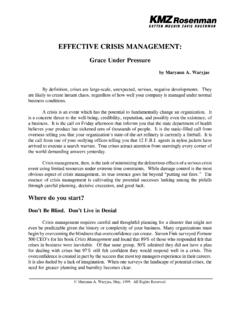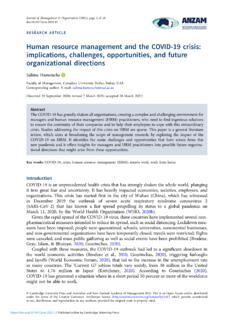Transcription of Crisis Management for Leaders Coping with COVID-19
1 Crisis Management for Leaders Coping with COVID-19 . Herman B. Dutch Leonard, Arnold M. Howitt, and David W. Giles1. Program on Crisis Leadership John F. Kennedy School of Government Harvard University April 2020. In the face of the rapidly evolving coronavirus Crisis that demands many urgent decisions but provides few clear-cut cues and requires tradeoffs among many critically important values, how can Leaders and their advisers make effective decisions about literally life-and-death matters? This policy brief contrasts the current Crisis environment with the more familiar realm of routine emergencies.
2 It argues that for crises, Leaders need to adopt a more agile, highly adaptive, yet deliberate decision-making method that can move expeditiously to action, while retaining the capacity to iteratively re-examine tactics in light of decision impacts. This method can help the team take account of the multiple dimensions of the COVID-19 Crisis and cope as well as possible with swiftly changing conditions. COVID-19 is, to be sure, an epidemiological and medical phenomenon but it is much more than that. It is also a deeply frightening and potentially traumatizing psychological event, a highly disruptive economic event, and a complex logistical event, among many other dimensions.
3 A conspicuous failure of the engagement with this phenomenon to date is the lack of integration of the understanding of COVID-19 as a medical phenomenon with its further implications for the full array of other components of the situation. The COVID-19 Crisis includes all of these components simultaneously, and effective leadership and Management of the Crisis requires addressing the entire picture. The challenge for Leaders is to operate in a way that embraces all of the elements together that is, to lead us through the whole event as a single, overarching, integrated, complex event. This is a profoundly different scope and scale of challenge than Leaders ordinarily face even in most significant emergency situations.
4 1 The authors are, respectively, the two Faculty Co-Directors and the Associate Director of the Program on Crisis Leadership, Harvard Kennedy School of Government, Harvard University. The observations about Crisis Management presented here result from our experience with and research on major Crisis events, interactions with Crisis Management Leaders through our research and executive programs, and from an extensive series of case studies that we have researched and written on Crisis events throughout the world. Crisis Management for Leaders Coping with COVID-19 page 1. Every significant emergency event is a fountain of issues, competing priorities, questions, decisions, and tasks.
5 Leading through an emergency event requires that the issues be identified, the priorities clarified, the questions framed, the decisions made, and the associated tasks directed and then carried out. In common emergencies what might be termed routine . emergencies the issues are familiar and have been raised repeatedly in prior events, so they are generally easy to identify; priorities have been debated in advance and are clear and agreed- upon; the key questions are evident and can be shaped for decision-making; the best decisions are framed and informed by prior experience; the tasks that flow from these best practices.
6 Decisions are readily apparent; it is clear what orders need to be issued; and the means to execute them are likely to be at hand. None of those conditions are present in the COVID-19 event. Few, if any, have lived through an event similar to the one now unfolding around us. The circumstances are dynamic, which implies (1) that we don't fully understand them as they exist at any given moment; and (2) they keep evolving and changing. Thus, our comprehension the basic premises, assumptions and understandings from which we derive our inclinations toward action is in continuous flux. This feels unsettling, even chaotic.
7 The situation has partial precedents, but no clear or complete analogies in prior experience. We face competing priorities, with no clear antecedent decisions about how to balance them. The issues that will be raised are not immediately obvious, clear, or well-defined. The questions that need to be grappled with are emerging, day by day; they cannot be accurately anticipated, and instead need to be identified, formulated, and reformulated as the conditions evolve. The decisions thus called for arise in real time as the questions are formulated, and they change and evolve with the situation and our grasp of it.
8 The tasks that flow from the decisions that are taken are not immediately obvious, nor is the best way to carry them out necessarily part of our repertoire of skills, processes, and resources developed from prior experience and action. Nearly everything about this event is unfamiliar. In a word, the situation we are confronting contains significant novelty. As an immediate consequence, there is no known playbook from which we can derive guidance about how best to proceed. Instead, we are forced to engage in real-time problem solving. What does this imply for Leaders trying to help their organizations make their way through these challenging circumstances, so profoundly different from leading in a business-as-usual environment?
9 The Routine Emergency Environment A routine emergency is characterized by familiarity. Consider, for example, an urban house fire being addressed by a well-trained and resourced fire department. Professional firefighters are familiar with the nature of the event and can generally predict with reasonable accuracy how it will evolve. As a result of prior experiences (theirs and others'), they have had a chance to determine the best ways to respond to it, and they have developed an organization well equipped to deal with such situations by combining standard operating procedures, plans, equipment, people with the requisite training, experience, and skills, and a structure for organizing and directing the response that is optimized for effectiveness and efficiency.
10 The response to the fire is expertise-driven: expert knowledge is embedded in the plans, the Crisis Management for Leaders Coping with COVID-19 page 2. training, the skills, the experience, the equipment, the procedures indeed, expertise is incorporated in every aspect of the organization and its processes and its people. The situation itself is also highly structured because of the firefighters' understanding of it. Situational awareness the ability to grasp the key elements of the situation can be achieved and maintained in routine events because people familiar with situations of this kind know what those key elements are that is, they know what to look for and how to find the key facts that characterize the situation and allow it to be understood and acted upon.
